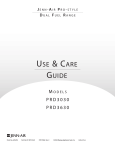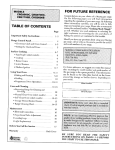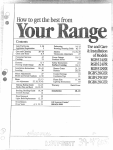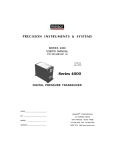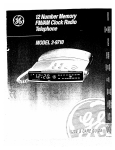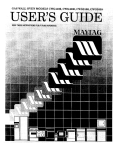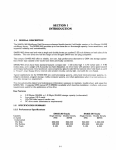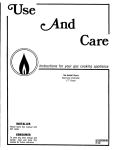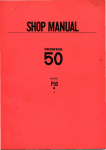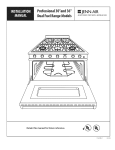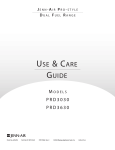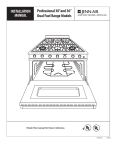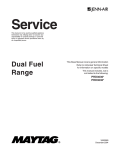Download Maytag Jenn-Air PRD3030 series User guide
Transcript
JENN-AIR
DUAL
PRO-STYLE
FUEL
RANGE
USE 8_ CARE
GUIDE
MODELS
PRD3030
PRD3630
I_]ENN-AIR
Form No.A/02/04
Part No.8113P419-60
P/N17666
Rev.C
@2004 Maytag
Appliance
Sales Co.
Litho U.S.A.
[A MESSAGETO OUR CUSTOMERS
J
For your convenience, product questions can be answered by Jenn-Air Customer Assistance
1-800-JENNAIR (1-800-536-6247)
1-800-588-2080 (U.S.TTY for hearing or speech impaired)
Mon. - FrL,8 am - 8 pm Eastern Time
Internet:
www.jennair.com
Maytag Services _"
Attn: CAIR_ Center
P.O.Box 2370
Cleveland, TN 37320-2370
/k
WARNING
If the information
in this manual is not foflowed exactly, a fire or explosion
may result causing property damage, personal injury or death. Do not store or
use gasoline or other flammable vapors and liquids in the vicinity of this or any
other appfiance.
/k
WARNING
To reduce the risk of injury to persons in the event of a rangetop grease fire,
observe the following: Smother flames with a close-fitting lid, cookie sheet, or
metal tray, then turn off the burner. Be careful to prevent
do not go out immediately
your
evacuate
ceil or land line phone
neighbor's
wet dishcloths
will result. Use an extinguisher
2) The fire is small and contained
Go to a
pan - You may be burned,
or towels
- a violent
steam
ONLY if:
I) You know you have a Class ABC extinguisher,
how to operate it.
3) The fire department
Never use
when you have a fire in your home.
home and call. Never pick up a flaming
DO NOT USE WATER, including
explosion
burns. If the flames
and call the fire department.
and you already know
in the area where it started.
is being called.
4) You can fight the fire with your back to an exit.
FOR YOUR SAFETY
If You Smell Gas:
! Do not try to light any appliance.
m Do not touch any electrical switch; do not use any phone in your building,
including cell phones.
! Immediately callyour gas supplier from a neighbor's phone. Follow the gas
supplier's instructions.
R If you cannot reach your gas supplier, call the fire department.
m Installation and service must be performed by a qualified installer, service
agency or the gas supplier.
PLEASE RETAIN THiS MANUAL
FOR FUTURE REFERENCE.
TABLE OF CONTENTS
SAFETY PRACTICES......................................................................................................................................................
3-5
MODEL
IDENTIFICATION
.............................................................................................................................................
6
BEFORE USING YOUR APPLIANCE
...................................................................................................................
7-8
COOKTOP USE...............................................................................................................................................................
9-I 2
Burner Use ............................................................................
9
Electronic Igniters ....................................................................
Burner Efficiency and Flame Characteristics
............................................
Sealed Top Burners ...................................................................
Burner Grates ........................................................................
Control Knobs ........................................................................
I0
10
10
11
11
Wok Ring ............................................................................
12
OVEN USE .......................................................................................................................................................................
13-23
Baking Tips ..........................................................................
Rack Positions .....................................................................
13
14-I 5
Convection Baking ...................................................................
Converting Recipes to Convection Baking ..............................................
Selecting Utensils for Convection Baking ...............................................
Regular Baking .......................................................................
Roasting .............................................................................
Broiling ..............................................................................
Condensation
........................................................................
To Get Best Results ................................................................
15
16
16
16
16
17
17
17-I 8
Setting Oven for Baking ...............................................................
High Altitude Baking .................................................................
Common Baking Problems .........................................................
Setting the Oven for Broiling .......................................................
Slow Cooking / Low Temperature Cooking .............................................
Suggested Temperatures to Keep Food Hot ............................................
19
19
19-20
20-22
22
23
OVEN SELF-CLEANING
MODES .....................................................................................................................
24-25
Oven Self-cleaning Mode .............................................................
Before Self-cleaning the Oven .........................................................
Setting the Oven for Self-clean ........................................................
At the End of the Clean Cycle ..........................................................
CARE AND MAINTENANCE
24
24
25
25
...............................................................................................................................
26-29
When Cleaning the Range or Cooktop
.................................................
Burner Grates ........................................................................
Burners ..............................................................................
26
26
27
Igniters ..............................................................................
Control Knobs ........................................................................
27
28
Backgua rd ...........................................................................
Oven and Door Interior ...............................................................
28
28
Oven Racks and Rack Supports ........................................................
Frame, Sides, Door Exterior, Heat Deflector ..............................................
Door Gasket .........................................................................
29
29
29
Oven Light Bulb Replacement .........................................................
Power Failure ........................................................................
29
29
PARTS IDENTIFICATION .......................................................................................................................................
30-31
BEFORE YOU CALL FOR SERVICE......................................................................................................................
32
WARRANTY ...................................................................................................................................................................
33-34
[SAFETY PRACTICES AND PRECAUTIONS
When properly
cared for, your new Jenn-Air Appliance
appliance.
When
appliance
provides
must be followed
using this restaurant
intense
caliber
has been designed
appliance,
when using kitchen appliances,
including
to be a safe, reliable cooking
use it with
heat and can increase the accident
]
extreme
potential.
care, as this type
Basic safety precautions
the following:
[]
Read this User Guide thoroughly
before using your new appliance.
of fire, electric shock, or injury to persons.
[]
Begin by insuring proper installation and servicing. Follow the installation instructions which came
with this appliance. Be sure to have a qualified technician install and ground this appliance before
using.
[]
Have the installer show you where the gas supply shutoffvalve
where to turn offthe gas to the appliance.
[]
If you smell gas, the installer has not clone a proper job of checking for leaks. You can have a small
leak and therefore a faint gas smell if the connections are not completely tight. Finding a gas leak
is not a "do-it-yourself"procedure.
Some leaks can only be found with the burner control in the ON
position and for your protection it must be clone by a qualified service technician.
/_
This will help to reduce the risk
is located so you will know how and
WARNING:
Gas leaks may occur in your system and result in a dangerous
leaks may not be detected
by smell alone.
Gas suppliers
purchase
and install an UL approved
gas detector.
accordance with the manufacturer's
instructions.
situation.
Gas
recommend
Install
and
you
use in
[]
If by some chance a burner goes out and gas escapes, open a window or a door to let the room air
out. Do not attempt to use the appliance until the gas has had time to dissipate.
Follow the
instructions on page 1,"For your safety - if you smell gas'.'
[]
This appliance has been factory assembled for natural gas. If using LP gas, the unit must
converted by a qualified service technician using the hardware provided in the conversion
packed with the unit. Refer to the instructions in the kit.
[]
Do not repair or replace any part of this appliance unless it is specifically
manual. All other servicing should be referred to a qualified technician.
[]
Children should not be left alone or unattended
in an area where appliances are in use. They
should never be allowed to turn knobs, push buttons, sit or stand on any part of an appliance.
[]
Children in walkers, or children crawling can be attracted to the round oven door handle and may
grab and open the oven door. This can result in injury from the door being pulled open on a child,
or severe burns if the oven is in use and hot.
Z_
recommended
be
kit
in this
WARNING:
Do not store items of interest to children above or at the back of any appfiance.
Children could be seriously injured if they should climb onto the appfiance
reach these items.
[]
Never store anything in the oven or on the cooktop. Flammable materials
items may melt or ignite and other types of items could be ruined.
[]
Do not hang articles from any part of the appliance
fabrics are quite flammable and may catch on fire.
[]
If the appliance is near a window
burners; they could catch on fire.
[]
Do not use water on grease fires. Turn all burners OFF,then smother
dry chemical or foam-type fire extinguisher.
or place anything
to
can catch fire, plastic
against the oven.
Some
be certain the curtains do not blow over or near the cooktop
3
fire with baking soda or use a
[ SAFETY PRACTICE AND PRECAUTIONS J
m
Never let clothing, pot holders, or other flammable materials come in contact with, or too close to,
any burner or burner grate until it has cooled. Fabric may ignite and result in personal injury.
m
Be certain to use only dry pot holders: moist or damp pot holders on hot surfaces may cause burns
from steam. Do not use a towel or other bulky cloth in place of pot holders. Do not let pot holders
touch hot burners, or burner grates.
For personal safety, wear proper apparel. Loose fitting garments or hanging sleeves should never
be worn while using this appliance. Some synthetic fabrics are highly flammable and should not
be worn while cooking.
Do not use aluminum foil to line any part of the oven or cooktop. Using a foil liner could result in
a fire hazard, or the obstruction of the flow of combustion and ventilation air. Foil is an excellent
heat insulator and heat will be trapped underneath
it. This trapped heat can upset the cooking
performance
and can damage the finish of the oven or the cooktop parts. Foil may also create a
shock hazard if the heating element were to short out.
Z_
WARNING:
This appliance is for cooking. Based on safety considerations,
never use the
oven or cooktop to warm or heat a room.
Also, such use can damage the
cooktop
or oven parts.
m When using the cooktop: Do not touch the burner grates or the immediate
adjacent to the burners may become hot enough to cause burns.
!
surrounding
area. Areas
When using the oven: Do not touch the interior surfaces of the oven, the exterior area immediately
surrounding the door or the back trim. The surfaces directly ahove the oven door may be hot if the
oven has been operated with the door open, or if something has prevented the door from sealing.
'_ Never leave the cooktop unattended when using high flame settings. Boil overs cause smoking
and greasy spill overs that may ignite. More importantly, if the burner flames are smothered by a
severe boil over which effects the igniter, unburned gas will escape into the room.
'_ Only certain types of glass, heat-proof glass-ceramic, ceramic, earthen ware, or other glazes utensils
are suitable for cooktop use. This type of utensil may break with sudden temperature changes. Use
only on low or medium flames settings according to the manufacturer's directions.
!
Do not heat unopened
food containers; a build up of pressure may cause the container
to burst.
'_ During cooking, set the burner control so that the flame heats only the bottom of the pan and does
not extend beyond the bottom of the pan. This could heat and/or melt the handles.
!
Always use utensils that have flat bottoms large enough to cover the burner.The use of undersized
utensils will expose a portion of the flame to direct contact and may result in ignition of clothing.
!
To minimize burns, ignition of flammable materials and unintentional
spill overs, position handles
of utensils inward so they do not extend over adjacent work areas, cooking areas, or the edge of the
cooktop.
[]
Hold the handle of the pan to prevent movement
[]
Grease is flammable. Let hot grease cool before attempting
to handle it. Avoid
deposits collect around the cooktop burners. Clean after each use or boil over.
[]
For proper lighting and performance of the cooktop burners, keep the burner ports clean. It may
be necessary to clean these when there is a boil over or when the burner does not light, even
though the electronic igniters click.
of the utensil when stirring
or turning
food.
letting
grease
[SAFETY PRACTICES AND PRECAUTIONS
]
Clean the cooktop with caution. Avoid steam burns; do not use a wet sponge or cloth to clean the
cooktop while it is hot. Some cleaners produce noxious fumes if applied to a hot surface. Follow
directions provided by the cleaner manufacturer.
Be sure all the range and/or cooktop controls are turned off and the appliance is cool before using
any type of aerosol cleaner on or around the appliance. The chemical that produces the spraying
action could, in the presence of heat, ignite or cause metal parts to corrode.
!!
Place oven racks in desired position while the oven is cool. Ira rack must be moved while the oven
is hot, do not let the pot holders contact the hot interior of the oven.
!!
Use care when opening
foods.
the oven door; let hot air or steam escape before removing
or replacing
m Do not rub, damage, move or remove the door gasket. It is essential for a good seal during
!
Clean the ventilator
hood and filters above the range or cooktop
cooking vapors does not accumulate on them.
!
Turn the ventilator OFF in case of fire or when intentionally"flaming"
liquor or other spirits on the
cooktop. The blower, if in operation, could unsafely spread the flames.
m DO NOT obstruct the flow of combustion
supply is available.
or ventilation
m For safety reasons and to avoid damage to the appliance
or cooking surface.
m Service should only be done by authorized
supply before servicing this appliance.
/_
frequently
baking.
air to the appliance.
so grease from
Be sure a fresh air
never sit, stand, or lean on the oven door
technicians.Technicians
must disconnect
the power
WARNING:
Cafifornia
Proposition
65 - The burning
by-products
which are known
reproductive
harm. California
potential
exposure
to such
of gas cooking
by the 5tare of California
law requires
substances.
and provide good ventilation
some
to cause cancer or
businesses to warn customers
To minimize
substances, always operate this unit according
this booklet
fuel generates
exposure
to the instructions
of
to these
con rained in
to the room when cooking
with gas.
MODEL IDENTIFICATION
36" DUAL FUEL RANGE MODEL
@ @ ®
@
Ooi
/
MODEL PRD3630
30" DUAL FUEL RANGE MODEL
I
@
\
MODEL PRD3030
/
BEFORE USING YOUR APPLIANCE
1) Remove all packaging
materials and labels from your appliance.
appliance, do it now. Check that you have the following
If the installer
has not set up your
items:
COOKTOP:
" 4 OR 6 burner head assemblies, burner caps and grates
27"&
24"OVEN:
! Two removable
Stainless Steel 3 position
! One, Two-piece
broil pan
Rack Slide Assemblies
m Three Oven Racks
NOTE: If any are missing, contact Jenn-Air Customer Assistance,
1-800-588-2080
(U.S. TTY for hearing
Model No., Serial No. and description
2) Place the oven racks in the proper position
check your recipe. The most frequently
from the bottom
1-800-JENNAIR (1-800-536-6247)
or speech impaired.)
Please be prepared
with your
of problem.
before turning
used position
on the oven. For correct rack position
is number 2. The rack positions
as in the floors of a building.
Rack Positions
I
"joooo ooo!
fi
--3
--2
1
Fig. 1
are numbered
BEFORE USING YOUR APPLIANCE
!
Do not use aluminum foil to cover the oven racks or to line the oven. Heat can be trapped
beneath the foil, this can cause damage to the oven and the food may not cook correctly.
3) Before baking or broiling:
One at a time turn the oven and broiler
manufacturing
on to "Broil'[
an odor.
oils used by the factory.
Turn on the ventilator
burners for 20 to 30 minutes
each.
This burnsoffthe
Turn the oven burner on to 450°F and the broiler burner
above your range while these burners are on, as there will be
TO INSERTTHE OVEN RACKS:
1 ) Hold the rack with the back safety rail in the up position
into the oven so the rack slides are between
and towards the rear of the oven. Slip it
the rack and the rack guides.
2) As you slide the rack into the oven tip the front of the rack up slightly, so that the safety stops on
the back of the rack, clear the rack slides. The safety stops keep the rack from sliding out of the oven
when pulled forward.
TO REMOVE OR REPOSITION THE RACKS:
1 ) Pull the rack forward.
2) Lift the front of the rack up so the safety stops clear the rack slides.
3) Pull the rack forward.
COOl(TOP USE
]
BURNERS
Cap
Your new professional
dual fuel range is equipped
with
burners that are designed for maximum cleanability and
controlability.
The burner should never be operated if the
cap
is not
electronic
burning
in place.
spark
All
ignition
pilots; when
the cooktop
burners
to
continuously
eliminate
the burner
have
is on and the flame is
blown out, it will relight.
SIMMERING
Your
new
professional
range
is equipped
with
Fig. 2
one
(PRD3030) or two (PRD3630) Dual Flow burners that have
exceptionally
low simmering
capabilities
Caps
(fig. 3). Keep in
mind that because of the high heat capacity of the outer
burner, and the mass of the cast iron burner grates (they
retain heat longer than lighter, conventional
foods
may continue
to cook
burner has been turned
over extinguish
by retained
grates) some
heat after the
off. Should a strong draft or boil
the simmer flame it will relight automat-
ically as the main burner would.
Fig. 3
SimmerlLow
Btu/hr
MaX.
Btu/hr
Nat
LP
Nat
LP
I
15,000
15,000
2
15,000
12,000
1,600
2,600
3
15,000
12,000
1,600
2,600
4
15,000
12,000
1,600
2,600
570~4,2001000~4,200
PRD3030 COOKTOP SECTION SHOWN
MaX.
Btu/hr
Nat
PRD3630 COOKTOP SECTION SHOWN
Simmer/Low
Btu/hr
LP
Nat
LP
1
15.000
15,000 i570~4,200 1000~4,200
2
15,000
12,000
1,600
2,600
3
15,000
12,000
1,600
2,600
4
15,000
12,000
1,600
2,600
5
15,000
12,000
1,600
2,600
6
15,000
15,000
570~4,200 1000~4,200
COOKTOP USE
ELECTRONIC IGNITERS
If a burner
does not ignite,
listen for the clicking
sound. If the
igniter is not clicking, TURN OFF THE BURNER. Check the circuit
breaker for a blown fuse or a tripped circuit breaker. If the igniter
still fails to operate, see page 32,"Before
You Call For Service'[ To
light the burner manually, see page 29,"Power
Failure'[
NOTE: If you are using propane gas, a slight pop or flash
may occur at the bumer ports a few seconds after
the burner has been turned "off': This "extinction
pop"is
normal for propane gas.
BURNER EFFICIENCY AND FLAME CHARACTERISTICS
It is necessary to keep the burner ports and the
igniters clean for proper lighting and efficient
performance
of the
cooktop
burner
should
burn completely
flame
burners.
Proper Flame Height
The
around
the burner with no excessive noise or lifting. On
natural
gas, the flame should
be blue in color
and stable. Slight yellow tipping
of the flames is
normal with LP gas. During initial use, foreign
particles in the gas line, or dust in the air around
the appliance
may cause an orange
will disappear
with use.
flame.This
FLAME HEIGHT
The correct
height of the flame mainly depends
on the size of the bottom
the material
of the cooking
of the cooking
Fig. 5
utensil,
utensil, the amount
and type of food and the amount
utensil. Following are some basic rules for selecting flame height.
! For safety reasons the flame must never extend beyond the bottom
allow flames to curl up the side of the pan (see Fig.S).
'_
of liquid
in the
utensil.
Never
of the cooking
Utensils which conduct heat slowly (such as glass-ceramic) should be used with medium to low
flame. If you are cooking with a large amount of liquid, a slightly larger flame can be used.
SEALED TOP BURNERS
The sealed top burners must be kept clean.
igniter. The cooktop
on the control
burners have an infinite
knobs between
and turn it counterclockwise
gas has been ignited
Cleaning
of the sealed top burners should include
HI and LO. To turn the cooktop
to the'LITE"
by the electronic
the
number of heat settings and there are no fixed positions
position.
burner on, push in on the control
An audible clicking
spark igniter, turn the knob to the desired setting.
sound should stop as soon as the burner is lit).
10
knob
sound will be heard. When the
(The clicking
[COOKTOP USE
//_
]
WARNING:
When turning
on any cooktop
before turning
the burner to a flame setting for cooking.
and it is turned
when
beyond the "LITE" position,
the burner
surrounding
burner, be sure to stop at the "LITE" position
does light.
This could
If the burner is not fit
there could be a burst of flame
cause burns
or damage
countertop.
BURNER GRATES
The burner grates are heavy cast iron.
They were
designed in sections to make them easier to remove
and clean. (See fig.6 & 7)
COOKWARE
For best results
cookware.
finer
we
recommend
This type of utensil
department
restaurant
using
professional
can be found
stores, specialty
cooking
at your
shops, or
supply stores. If using regular cookware,
be
very careful if the pans have plastic handles, as these
large professional
size burners
can flame
up on the
outside of the pan and melt or bubble the handles.
CONTROL
KNOBS
The control
knobs
are readily
associated
with
Fig. 6 (36"model)
the
burners they control. The cooktop control knobs are
labeled and in front of the burners. The oven control is
placed slightly lower than the other control knobs. This
is due to the physical
thermostats
size of the commercial
used on the product
type
(see fig.8).
Fig. 7 (30" rnodel)
Fig. 8
11
to the
COOKTOP USE
WOK RING
A Wok ring is provided
with your new appliance.
finish. It can be used with most commercially
The ring is cast iron, and has a porcelain
available woks. To use the ring, place it on the grate over
the desired burner. The vertical tabs on the ring should be aligned
The small protrusions
the ring from rotating
retained
on the bottom
during
surface of the ring should
cooking.
enamel
See fig. 9. The bottom
with the main fingers of the grate.
straddle the grate fingers to prevent
of the wok should
be supported
and
by the vertical tabs of the ring.
To clean the wok ring, place it in the dishwasher
by soaking to loosen the soil, then washing
Top View of
after use. Stubborn
food deposits
may be removed
as usual.
_
j
Vertical tabs
Wok Ring
I
I
I
Main fingers
0
000
Fig. 9
12
[OVEN USE
OVEN COOKING ELEMENTS
Your new professional range is equipped with bake and broil cooking elements.
On the PRD3630
Model, the oven bakes at 5,000 Watts. On the PRD3030 model, the oven bakes at 3,700 watts. Both
ovens broil at 4,000 Watts.
OVEN
Your new oven can be used in three cooking
modes; convection
bake, regular
To help you decide which way to cook your food read this information
oven and the thermostat
has been checked
for accuracy.Your
that over the years got a little hot or a little cold.
Use caution
compensating
for your old oven being out of calibration.
this is a new
old oven may have had a thermostat
Check your
temperature.
bake, and regular broil.
first. Remember
recipes for the correct
when using your old oven's time or temperature.
time and
You may have been
BAKINGTIPS
Use a reliable recipe and accurately
temperature
and cooking
Use the correct rack position.
! Top browning
! Bottom
Bakeware
Carefully
Baking results may be affected
if the wrong
rack position
may be darker if food is located toward the bottom
plays an important
called for in the recipe. Cooking
part in baking
times or cooking
results.
for oven
is used.
of the oven.
Always use the type and size of pan
results may be affected
! Shiny metal pan reflects heat away from the food, produces
Use shiny pans for baking cakes or cookies.
!
follow directions
may be darker if food is located toward the top of the oven.
browning
material
measure fresh ingredients.
time. Preheat oven if recommended.
lighter
if the wrong
browning
size is use.
and a softer crust.
Dark metal pan or a pan with an anodized (dull) bottom absorbs heat, produces
browning and a crisper crust. Use this type of pan for pies, pie crusts or bread.
darker
! For optimum baking results, bake cookies and biscuits on a flat cookie sheet with one lip. If the
pan has sides, such as a jelly roll pan, browning may not be even.
! If using oven-proof glassware, or dark pans such as Baker's Secret reduce the oven temperature
by 25°F except when baking pies or bread. Use the same baking time as called for in the recipe.
! If using insulate bakeware, expect cooking times to increase slightly.
the oven temperature.
Check the cooking
progress at the minimum
time recommended
It is not necessary to adjust
in the recipe. If necessary, continue
checking at intervals until the food is done. If the oven door is opened too frequently,
from the oven; this can affect baking
If you add additional
ingredients
heat will escape
results and wastes energy.
or alter the recipe, expect
slightly.
13
cooking
times to increase or decrease
OVEN USE
OVEN RACKS
The oven comes standard with (3) oven racks and three position
piece porcelainized
from the bottom
steel broiler pan is included
with this oven. Rack positions are numbered
of the oven, with rack #1 closest to the bottom
RACK 3: Used for most broiling, toasting
roller assisted rack supports.
bread, and two-rack
A twostarting
and rack #3 closest to the top.
baking.
RACK 2: Used for most baked goods on a cookie sheet or jelly roll pan, or frozen convenience
foods, for two-rack baking, baking bread, or large cakes.
RACK 1: Used for roasting small cuts of meat, large casseroles, baking loaves of bread, cakes (in
either tube, bundt, or layer pans), for roasting large cuts of meat and large poultry, pies, souffles,
or angel food cake, or for two-rack baking.
RACK POSITIONS
'_ For optimum
results, air must circulate freely within the oven and around the food. To help
ensure this, place food in the center of the oven. Allow two inches between the edge of the
pan(s) and the oven walls.
If Use one rack for optimum
cakes, cookies or biscuits.
baking
results
of
Position the rack so the food is in the center of
the oven. Use rack position
2.
!!
If cooking on two racks, stagger the food to
ensure proper air flow (see illustration
to the
right).
I!1
If cooking
on two racks, use rack positions
2 and
3 for cakes. When using cookie sheets, never
place two cookie sheets on one rack. Stagger
them on racks 2 & 3 as illustrated.
'_ If roasting a large turkey, place the turkey on rack 1.
!
Do not use cookware
that extends beyond the edge of the rack.
PAN POSITIONS
1 PAN
Center the rack in the middle of the oven and center the pan on the
oven rack.
2 PANS
Allow 1-2 inches of space between
3-4 PANS
Use two racks and stagger
another
pans and oven walls
pans so one pan is not directly
pan.
14
over
OVEN USE
NOTE: About
]
the roller assisted
Specifically
to years
engineered
of use.
heavy
food
before
the oven
rack supports:
from high temperature
They are especially
products
associated
materials
functional
with this
when
for in-oven
the
high capacity
can be put into self clean.
oven
use, they will stand
racks are supporting
oven.
They
must
up
the
be removed
See page 29 for care of the rack supports.
CAUTION:
Aluminum
bottom.
foil should never be used to cover the oven racks or to line the oven
The trapped heat can damage
adequately
the porcelain
and the heated air cannot
reach the food being baked.
A small piece of foil may be used to catch spillovers.
Place it on a lower rack several inches below the
food.
foil. This prevents fat from draining
Do not cover the broiler insert with aluminum
below and increases flare-ups
and smoke.
into the pan
However, the broiler pan may be lined with foil for easier
clean-up.
Rack positions
for Baking
One or two racks can be used simultaneously
during
before turning
rack(s) out of the oven.
bottom)
the oven on. Store any unused
will probably
be used the most for single
bake. Place the rack(s) in the desired position
rack baking.
Rack position
2 (second from
If you are using two racks simulta-
neously, be sure to check the food on the bottom rack sooner than the minimum time. The food on
the lower rack position may cook slightly faster than the food on the upper rack, particularly if you are
using large baking utensils.
If you are using two racks simultaneously,
be sure to stagger the baking utensils so that one is not
directly above the other and the heated air can circulate
on page 14. If using large or commercial
as the air cannot circulate
freely around each pan. See "Rack Positions"
size baking utensils, the food may take a few extra minutes
as freely as it does with a smaller pan. When using commercial
size baking
utensils, use only one rack as the heat does not have the room to circulate.
Rack positions
for Convection
All racks can be used simultaneously
before turning
bottom)
Baking
during convection
baking.
Place the racks in the desired position
the oven on. Store the unused racks out of the oven. Rack position
will probably
be used the most for single rack baking.
2 (second from
When baking on more than one rack
you do not need to stagger the pans. Place on top of each other like cookie sheets, etc.
CONVECTION
Convection
pattern
BAKING
baking is baking with a fan at the back of the oven circulating
around
effectively
the food.
This circulating
than in a standard
hot air heats and browns
oven. This allows most foods to be cooked at lower oven temperatures
or in less time, if baked at the regular temperature.
longer cooking
baking
The air is recirculated
and reheated.
foods such as large pieces of meat or other foods that can be cooked
utensils
Using multiple
the hot air in a continuous
the surface of the food more
or air leavened
foods, are where
you will see the most savings in cooking
time.
racks at the same time will achieve a good time saving, as you can cook more food at
the same time. Convection
baking is good for large quantities
of baked foods such as cookies, biscuits,
muffins, brownies, cupcakes, pies, sweet rolls and bread.
Foods Suitable
I! Appetizers
'_ Cookies
Uncovered,
in low sided
for Convection
I! Breads
'_ Main Dishes
I! Oven Meals (1 to 3 racks)
'_ Roasts
'_ Pies
]5
'_ Poultry
[
OVEN USE
[] Air Leavened Foods (Angel Food Cake, souffl6s, cream puffs,
[] Meats are juicier and more flavorful because the circulating
browning.
[] Yeast breads are lighter, more evenly textured, more golden
[] Airy foods such as angel food cake, cream puffs, puff pastry
[] Multiple-rack baking speeds quantity baking.
Converting
Recipes to Convection
meringue shells)
hot air seals the surface and enhances
brown and crustier.
and meringues are higher and lighter.
Baking
Low sided baking utensils will give the best results as the hot air can reach all sides of the food easier.
The oven temperature
The temperature
can be left the same as the recipe and the food cooked a shorter
can be lowered 25°F and the food will probably
as the recipe states. If you find that food is adequately
center,
lower
temperature
the temperature
another
browned
25°F and add to the
period of time.
take the same length of time to cook
on the outside, but not done in the
baking
time.
When
reducing
always check the food for doneness, a minute to two before the minimum
the
time stated in
the recipe, as time can always be added. Some recipes will cook faster than others. There is no way to
predict exactly how long each recipe will take when you convert
it to convection.
easier to use after you have used it a few times as you will begin to understand
Selecting
Cooking
Utensils
by convection
for Convection
does not require
baking
to use. When choosing
utensils.
Metal bakeware (aluminum,
browning,
Aluminum
You probably
have
a baking utensil, consider the
material, the size and the shape as they all affect the baking time, the palatability
time and the best end product.
will be
Baking
any specially designed
many utensils in your kitchen that are suitable
of the finished product.
Convection
the way it bakes.
and the appearance
steel and cast iron) all result in the fastest cooking
pans work best for all types of baked goods.
For the best
use a pan with a dark or dull finish that absorbs heat, when baking pies and breads. A shiny
finish works best for cakes and cookies, since it reflects some of the heat and provides a more tender
surface.
around
Cookie sheets with only one lip will give the best results, as the heated air can circulate
the sides of the food.
For roasting
use the bottom
metal V-shaped roasting rack. Glass-ceramic or glass utensils do not conduct
they can be used.
souffles.
Use them
all
of the broil pan and elevate the meat on a
for foods that do not require
a dark brown
Baked items cook more quickly and evenly if they are individually
heat as well as metal, but
crust or crisping,
such as
smaller in size, i.e.two or three small
foods do better than one large piece. When single food items are baked, always center the food on the
rack. If several foods are being baked, space them evenly on the rack or racks.
REGULAR BAKING
Bake is baking with hot air;there
is no fan. The air movement
comes from natural convection.
As the
air heats, it moves to the top of the oven. This oven mode is the same as you have been using for
baking on one or two racks.
Foods Suitable
[] Appetizers
[] Desserts
for Bake
[] Pies, Cakes
[] Main Dishes
[] Breads
[] Poultry
[] Oven Meals (1 to 2 racks)
[] Roasts
[] Casseroles
ROASTING
Roasting is the method
for cooking
large, tender
cuts of meat uncovered,
without
adding
moisture.
Most meats are roasted at 325°F. It is not necessary to preheat the oven. Some good choices are: beef
rib, ribeye, top round, high quality tip and rump roast, pork loin roast, leg of lamb, veal shoulder
and cured or smoked hams.
16
roast
[OVEN USE
BROILING
Broiling is cooking
by intense infrared radiation
oven. Since broiling
is cooking
mode. Cooking time is determined
food and the element.
Foods Suitable
[] Top Browning:
[] Appetizers
supplied
by the broil element
located at the top of the
by radiant heat it is not necessary to use the convection
by the desired degree ofdoneness
fan in the broil
and the distance between
the
for Broil
Casseroles, Breads
[] Meats
[] Poultry
[] Fish
CONDENSATION
During any cooking
process there is a certain amount
amount
that condenses
of moisture
of moisture
on the oven depends
that evaporates
on the moisture
from the food. The
content
of the food.
The
moisture will condense on any surface that is cooler than the inside of the oven, such as the control
panel or the top of the door.
TO GET THE BEST RESULTS
Baking:
m Follow the recipe amounts and ingredients, including the size and shape of the baking utensil
recommended in the recipe.
m Do not open
window.
the open door "just to peek',' use the interior oven light and look through
the
!! Do not use the oven for storage, especially when baking in the oven. Extra utensils, not being
used for baking, can affect the food product, the baking time, the browning and end result.
!! When opening the oven door, allow steam and hot air to escape before reaching
to remove food.
!! Do not rely on time or brownness as the only indicators
toothpick,
instant read thermometer, etc.
!! If you are using glass utensils, lower the temperature
!! Use a minute timer, set for the minimum
Convection
of doneness;
into the oven
test with
finger tip,
25°F.
time suggested
in the recipe.
Baking:
!! Follow the first four recommendations
in the baking section.
!! Metal utensils give better results, in convection, than do glass baking utensils.
it usually is not necessary to lower the temperature an additional 25°F.
If you use glass,
!! Use a minute timer, set for less than the minimum time suggested in the recipe, the first time
you use a recipe in the convection mode. Be sure to note the new baking time on your recipe,
for future reference.
m Be sure to read the basic information
on convection
before using the oven for the first time.
!!1 Keep in mind that convection baking results vary, depending
standard bake yields superior results over convection.
on type of product.
In many cases,
Roasting
!!1 For best results use tender
cuts of meat weighing
3-1bs.or more.
!!1 Place the meat fat-side-up on a V-shaped rack in a shallow roasting pan. Placing the meat on a
V-shaped rack holds it out of the drippings, thus allowing better heat circulation for even
cooking. As the fat on top of the roast melts, the meat is basted naturally, eliminating the need
for additional basting.
17
OVEN USE
m The cooking
time is determined
by the weight
of the meat and the desired doneness.
!! For more accurate results, use a meat thermometer.
Insert it so the tip is in the center of the
thickest part of the meat, going in horizontal into the meat. It should not touch fat or bone.
!! Remove the roast from the oven when the thermometer
registers the desired doneness.
with foil, let rest for 15-20 minutes, juices will go back into the meat and slice nicely.
NOTE: For more
information
1-800-368-3138.
Association,
Convection
about
food
For cooking
safety,
call
information,
444 North Michigan
USDA's Meat
write
& Poultry
to the National
Cover
Hotline
Cattlemen's
at
Beef
Avenue, Chicago, Illinois 6061 I, or call 1-800-368-3138.
Roasting
m Do not reduce oven temperatures.
percent.
However, roasting time should be reduced
by up to 25-30
!! Do not use a roasting pan with high sides. A two-piece broiler pan may be used if the pan is
greater than 1-1/2 inches in depth. Place V-shaped rack in the bottom of the broiler pan and
then place the food on top of the V-shaped rack or on top of the two-piece broiler pan.
!! Do not cover meat or use an oven cooking
bag.
!! Since the breast meat and drumsticks on a turkey cook more quickly than the thigh areas, place
a "foil shield"over these areas after desired brownness is reached to prevent overbrowning.
REGULAR & CONVECTION
ROASTING
CHART
(THAWED MEATSONLY)
CUT OF MEAT
REGULAR CONVECTION
Appr0x.Weight
(pounds)
Standing
Rib Roast
(min.per lb.)
Approx/x
RoastingTime
325 °
145°F (reed/rare)
25-35
20-30
160°F (mecR
145°F (reed/rare)
30-35
25-35
25-30
20-30
350 °
160°F (reed)
30-35
25-30
Tenderloin Roast
Fresh Ham Roast
2 to 3
4 to 6
Shoulder
4 to 6
400 °
325 °
325 °
145°F (med/rare)
170°F
160°F
20-30
35-45
30-40
15-25
30-40
20-30
3 to 4
325 °
160°F
25-30
20-25
5 to 7
boneless) .××
325 °
140°F
25-35
N/A
5 to 7
325 °
160°F
35-45
30-40
12 to 16
_
_
18-20
12-16
16to20
20to24
325 °
325 °
180°-185°F
180°-185°F
16-18
14-16
10-15
8-10
Turkey Breast
Chicken
3 to 8
3 to 4
325 °
350-375 °
170°F
180-185°F
30-40
20-25
25-35
15-22
Leg (boneless)
2 to 3
325 °
160°F (reed)
170°F (reed)
35-40
40-45
20-25
35-40
Whole Leg
5 to 7
325 °
160°F (reed)
30-35
25-30
170°F (reed)
35-40
30-35
Blade Roast
a
a
_oon_l_eto re eating)
Turkey, unstuffed***
'_Cooking
(min.per lb.)
Approx.x'
RoastingTime
4 to 6
_am Half
uIly cooked
_E
Internal
Temperature
Rib Eye Roast
Pork Loin (boneless)
0
4 to 8
Oven
Temperature
(in °F)
times are approximate
and may vary depending
on the shape of the roast.
Cx
....Add water andfollow packagedirections. Not recommendedfor ConvectionRoasting
Stuffedturkey requiresadditional roastingtime. Shieldlegsand breastwith foil to preventoverbrowning and drying of skin.
18
OVEN USE
]
PREHEATING
Preheating
takes about 10 to 15 minutes depending
for baking.
The oven heating
on the temperature
set. Preheating
light will turn off when the oven has reached
necessary to preheat for roasting.
Selecting
a temperature
is necessary
temperature.
It is not
higher than desired will NOT preheat the
oven any faster, and may have a negative effect on baking results.
SETTING THE OVEN FOR BAKING
Decide
if you are going
roasting or warming
to use BAKE or CONVECTION BAKE. These cooking
modes are for baking,
using one, two or three racks. If you are going to use regular Bake, simply push in
the "BAKE" switch on the valve panel, above the large oven knob and turn the control
temperature
control
used in the recipe. To use Convection
Bake push the convection
panel) and turn the control knob to the temperature
knob to the
switch (located on the
desired.
1) Press BAKEor CONVECTIONBAKESelector switch.
! The convection
2) Set desired Temperature
fan will turn on if "CONVECTION BAKE" is selected.
on Thermostat
Control
Knob.
m The"OVEN ON" light turns on.
'_ The "HEATING" light turns on.
'_ Once the"HEATING"
light cycles off the first time, the oven is preheated.
! The"OVEN ON" light remains on until the"OFF" Selector switch has been
pushed, or the Thermostat has been turned to the "OFF" position.
High Altitude
Baking
Recipes and baking times vary if you are baking
the Agriculture
Extension
type of information
Service, Colorado
and the baking
at a high altitude.
For accurate
information write to
State University, Fort Collins, Colorado
mode (convection
80521. Specify the
bake or bake) you need i.e. cakes, cookies,
breads, etc. There may be a cost for the bulletins.
COMMON
BAKING
PROBLEMS AND WHYTHEY
PROBLEM
HAPPEN
POSSIBLE CAUSES
Cakes are uneven.
[] Panstoo close or touching each other or oven walls. [] Batter uneven in
pans. [] Temperature set too low or baking time too short. [] Oven not level.
[] Undermixing. [] Too much liquid.
Cake high in middle.
[] Temperature set too high. [] Baking time too long. [] Overmixing. [] Too
much flour. [] Panstouching each other or oven walls. [] Incorrect rack position.
Cake falls.
[] Too much shortening or sugar. [] Too much or too little liquid. []
Temperature set too low. [] Old or too little baking powder. [] Pan too small.
[] Oven door opened frequently. [] Added incorrect type of oil to cake mix.
[] Added additional ingredients to cake mix or recipe.
Cakes, cookies,
biscuits
[] Incorrect
don't brown evenly.
aluminum
rack position.
not sealing properly
foil
For optimum
[] Oven door not closed properly.
or properly
attached
[] Oven not preheated.
to door.
[] Pans darkened,
results, bake on one rack. If baking
use of
dented
or warped.
cakes on two racks, stagger the
cake pans to ensure proper air flow. Check picture
19
[] Door gasket
[] Incorrect
on page 14.
[
OVEN USE
COMMON BAKING PROBLEMS AND WHY THEY HAPPEN (CONTINUED)
PROBLEM
POSSIBLE CAUSES
Cakes, cookies,
biscuits
[] Oven not preheated.
too brown on
cookie sheets on one rack. [] Used glass, dark, stained
bottom.
metal pans. (Use a shiny cookie sheet.)
[] Incorrect
[] Pans touching
rack position.
Follow cookware
[] Incorrect
manufacturer's
Glassware and dark cookware
lowering
Cakes don't
Uneven
Cakes
rack position.
by 25°F.
[] Temperature
set too low. [] Overmixing.
[] Too
in pan. [] Oven door
[] Too little leavening, [] Overmixing.
[] Pan too large. [] Temperature set too
high. [] Baking time too long, [] Pans too close to each other or oven walls,
shrinkage
texture.
[] Too much liquid.
too short.
have tunnels.
[] Not enough
[] Undermixing,
shortening.
in
[] Temperature
[] Temperature
[] Too much baking
too high a speed. [] Temperature
Cake not clone
or dull finish
for oven temperature.
much liquid. [] Pan size too large or too little batter
opened too often,
on top.
Excessive
instructions
foil. [] Placed 2
warped
such as Ecko's Baker's Secret may require
the oven temperature
[] Incorrect
brown
each other or oven walls.
use of aluminum
set too low. [] Baking time
powder.
[] Overmixing
or at
set too high.
set too high. [] Pan too small. [] Baking time too short.
middle.
If additional
increase.
Pie crust
edges
too
ingredients
[] Temperature
brown.
were added
set too
high.
to mix or recipe, expect cooking
[] Pans touching
each other
time to
or oven
walls.
[] Edges of crust too thin; shield with foil.
Pies don't
brown
on
[] Used shiny metal pans. [] Temperature
bottom.
[] Some frozen pies should
directions.
Pies have soaked
[] Temperature
metal pans.
crust
set too low. [] Incorrect
rack position.
be placed on a cookie sheet, check package
too low at start of baking.
[] Filling too juicy.
[] Used shiny
SETTING THE OVEN FOR BROILING
When
the "Broil"
current
above
during
open
selector
switch
the oven
door
door.
broiling.
is pressed
you will
This air current
The cooling
hear a cooling
serves
fan must
fan begin
to keep the
be running
control
to operate
area above
for the broiler
and feel an air
the
oven
cooler
to operate.
Preheating
For best
mately
results,
it is recommended
10 minutes.
After
that
preheating,
the
place
oven
the food
be pre-heated
in the oven
with
and
the
door
closed
leave the door
open
with
nearby.
for approxiat broil
stop.
To Get the Best Results
m Defrost
the
food
R Leave the door
before
starting
ajar at the
broil
to cook.
stop. Never
"open
door
broil"
children
NOTE: If the door is closed during broiling, the oven cavity may get hot enough to cycle the
broil element on and off, producing food that tastes baked/roasted instead of
broiled.
2O
OVEN USE
Set a minute timer for the minimum
time to check the food. Steaks should be at least one inch
thick ira rare doneness is desired. It is difficult
nice brown piece of meat.
to get rare with meat that is thinner, or to get a
m
For best results, steaks and chops should be at least 3/4-inch
broiled.
m
Before broiling, trim excess fat to prevent
outer edges of the fat to prevent curling
excessive
thick. Thinner cuts should be pan
spattering
or smoking.
Cut slashes in the
during cooking.
m
Season meat after cooking.
B
Use a broiler pan with an insert designed to drain excess liquid and fat away from the cooking
surface. This is to prevent spatters and smoke.
B
For a brown exterior and rare interior, meat should be close to the broil element.
Salt tends to draw juices out of the meat and delay browning.
For well-clone
meat, place the broiler pan farther from the element.
B
Increasing the distance
and smoking.
between
the meat and the broil element
will help reduce spattering
B
Select rack #1 or #2 for longer cooking
chicken breast and turn 3 times.
B
Foods that require turning should be turned only once during broiling, except for chicken. Turn
after half the recommended
cooking time.
B
It is not necessary to turn over thin foods
turned over.
B
When top browning, use metal or glass-ceramic bakeware. DO NOT use heat-proof glass or
pottery as this type of glassware cannot withstand the intense heat of the broiler burner.
foods such as chicken pieces. Broil rib side-up first for
(filet of fish, ham slices, etc.)
Liver slices must be
NOTE: You cannot use the broiler and the bake element at the same time. When one is on,
the other cannot be turned on. Do not use the convection fan in the broil mode.
BROILING
TYPE OF MEAT
CHART
RACK POSITIONS _-
DONENESS
BACON
BEEF STEAK
3
3
Well Done
Medium
6 to 10
15 to 18
I-inch thick
3
Well Done
19 to 23
CHICKEN
Pieces
1 or 2
FISH
1 or 2
Fillets
Steaks, 1-inch thick
GROUND BEEF PATTIES
3/4-inch
thick
HAM SLICE, precooked
]/2-inch thick
PORKCHOPS
]-inch thick
*The top rack position
** Broiling
Flaky
8 to 12
3
Flaky
10 to 15
3
Well Done
15 to 18
3
Warm
8 to12
Well Done
22 to 26
3
is position
times are approximate
30 to 50
3
3
TOAST
Well Done
TOTAL COOKTIME
Golden
Brown
#3,
and may vary depending
21
on the meat.
2 to 5
(MINUTES)
_
OVEN USE
Using a Meat Thermometer
To accurately
determine
to Broil
the aloneness of a thick steak or chop (] -1/2 inches thick or more), use a meat
thermometer,
insert the point of the thermometer
into the side of the meat to the center. Cook the
first side to 90°F for rare meat. Cook the first side to ] 00°F for medium to well done. Cook the second
side to the desired degree for the aloneness you want, 135°F to 140°F for rare, and ]50°F to 155°F for
medium
and ] 50°F to 165°F for well done.
if you are cooking pork, cook to 160°F. A large two-piece
broil pan comes with your new range. When you are broiling, always use both pieces. Do not cover the
grid with aluminum
foil. This slotted grid allows the grease drippings
pan keeping it away from the intense heat of the broiler element.
and spattering
to flow into the bottom
This helps to minimize
of the
the smoking
of the grease.
NOTE: When the oven is used for an extended period of time at a high temperature, the
cooling blower may turn on. This is normal The cooling blower will also operate
during Broil and the Self-Cleaning cycle. If the blower is not running during these
modes, do not use the oven. Call a qualified appliance technician to repair the unit.
Oven
Rack Position
The rack position
would
typically
depends
on the type and thickness
be broiled on rack position
of the food.
Thick pieces of meat or poultry
1, steaks, chops and hamburger,
position
3. If top browning
casseroles or bread the thickness
position.
Casseroles and bread would typically
USING THE OVEN FOR SLOW COOKING
be browned
would
be broiled on rack
of the food would
indicate
the rack
on rack position 2.
OR LOWTEMPERATURES
The oven can be used to keep hot food hot, to dehydrate
food, to warm plates, for slow cooking
(as in
a crock pot), and to defrost foods.
You can keep hot, cooked food at serving temperature.
Set the oven to the temperature
the chart. Rare meat must be eaten when it is removed from the oven, as it continues
own heat.
[]
To keep food moist, it must be covered with aluminum
[]
To dehydrate
[]
To warm plates, check with the dishware
[]
Do not use plastic wrap or wax paper in the oven.
food, follow
suggestions
suggested
cooking
from its
foil or a lid.
in a recipe.
manufacturer
for the recommended
temperature.
FOOD SAFETY:
According to the United States Department of Agriculture you should not
hold foods at temperatures between 40°F to 140°F for longer than 2 hours.
22
in
OVEN USE
SUGGESTED TEMPERATURES TO KEEP FOOD HOT
Food
Oven
Temperature
Food
Beef
Rare
Medium
Well Done
Bacon
Biscuits and Muffins
150 ° 155 ° 170 °200 ° 170 ° -
155°F
170°F
180°F
225°F
185°F
(covered)
Oven
Temperature
Lamb and Veal Roasts
170°-200°F
Pancakes and Waffles
(covered)
Potatoes
200 ° - 225oF
Baked
200°F
Mashed (covered)
Pies and Pastries
170 °- 185°F
170°F
Pizza (covered)
Pork
225°F
170 ° - 200°F
Casserole (covered)
Fish and Seafood
170 ° - 200°F
170 ° - 200°F
French Fried Foods
200 °- 225°F
Poultry (covered)
170 ° - 200°F
Gravy or Cream Sauces
(covered)
170 ° - 180°F
Vegetables (covered)
170 ° - 175°F
INTERNAL
COOKING TEMPERATURES
Food
Oven
Temperature
Egg and Egg Dishes
Egg Casseroles
Egg Sauces, Custards
Ground
Oven
Temperature
Poultry
Cook until yolk
and white are firm
Eggs
Food
160° F
160° F
Chicken,Turkey-whole
Chicken,Turkey-dark
180°F
meat
180°F
Poultry-breast
170°F
Duck and Goose
180°F
Meat and Meat Mixtures
Turkey, Chicken
165°F
Beef, Veal, Lamb, Pork
160°F
Stuffing
Cooked alone or in bird
Sauces, Soups, Gravies, Marinades
Fresh Beef, Veal, Lamb
145°F
Used with raw meat,
Medium
160°F
poultry, or fish
Well Done
170°F
Medium
Rare
165°F
Fresh Pork
Medium
160°F
Well Done
170°F
Seafood
Fin Fish
Shrimp, Lobster,
Crab
Bring to a boil
Cook until opaque
and
flakes easily with a fork
Should turn red and flesh
should
become
pearly
opaque.
Roast Beef
Scallops
Cooked commercially,
vacuum
140°F
Clam, Mussels,
Oysters
sealed, and
Should turn milky white
or opaque and firm.
Cook until shells open.
ready-to-eat
Leftovers
23
165°F
OVEN SELF-CLEANING MODE
OVEN SELF-CLEANING MODE
The self-cleaning
oven of your new range features pyrolytic
the oven reaches a high temperature
cooktop
burners
depending
may be used.
on the content
self-cleaning.
When set in the clean mode,
that burns off the food soil. When the oven is set for clean, the
It is common
and amount
to see smoke and/or
of soil remaining
oven and allow it to cool before opening
in the oven.
flames
during
the clean cycle,
If a flame persists, turn off the
the door to wipe up the excessive food soil. At the end of the
clean cycle, some gray ash or burned residue may remain inside the oven. This is a mineral deposit
does not burn or melt. The amount
oven was cleaned.
of ash depends
It is easily removed, once the oven has cooled, using a damp paper towel, sponge,
or cloth. Wipe offany
smoke residue that remains on the front frame with Formula 409 ° or Fantastik ®.
If stain remains, use a mild liquid cleanser. The amount
of smoke stain is directly
of food soil left in the oven at the time of self-cleaning.
Clean the oven often.
OVEN DOOR LOCK DURING
SELF-CLEAN
oooo_oo[]
When the clean cycle starts, the lock light turns
on, and the automatic
to open the door when the
lock light
You can stop the cycle
pushing the OFF button.
Oven front
e'_ra me
by
Outer door
The lock light will turn
off only after the oven has cooled
and the automatic
related to the amount
door lock cycle begins.
DO NOT attempt
is on.
that
on how heavily soiled the oven was before the
dge
below 550°F,
door lock has completed
its
cycle to the open position.
BEFORE SELF-CLEANING
THE OVEN:
[] Remove all utensils and racks.
[] Clean the oven front frame and outer
door edges.
Wipe up large spillovers
and grease. (see fig. 10)
[]Be
sure the
light
bulbs
covers are in place.
[] Turn on the ventilator
and
glass
hood above the
range and leave it on until after the
oven
has completed
cycle.
[] Remove
Oven
the
Racks and
self-clean
Rack Slide
Assemblies.
Fig. 11
NOTE: An Interlock System has been
until the Rack Slide Assemblies
are designed to withstand the
They will not withstand the
remove the Assemblies:
designed so that the Self-Clean Cycle wifl not engage
have been removed. The roller assisted rack supports
temperature range of the standard baking thermostat.
extreme temperatures of pyrolytic self cleaning.
To
A) For each side, remove the retaining
screw,
B) Lift up slightly and pull the entire assembly out. Set aside.
Replace the assemblies and retaining screws after the Self-Clean
cycle has finished.
24
OVEN SELF-CLEANING MODE
OVEN RACK SLIDE ASSEMBLY
Wipe out puddles of grease and any loose soil that can be easily removed.
outside the door seal area. This appliance
is designed
Remove any soil that is
to clean the oven interior
and that portion
of the
door that is inside the oven. The outer edges of the door and the oven cavity are not in the cleaning
zone. Wipe this area clean before setting the oven to self-clean.
'_ Turn on the ventilator
self-clean cycle.
hood above the range and leave it on until after the oven has completed
the
SETTING THE OVEN FOR SELF CLEAN
1) Push the"CLEAN"
Selector Button.
2) Set Oven Control
Knob to"CLEAN':
m Cooling
Blower turns on,
! OVEN ON light and HEATING light turn on,
m LOCK light turns on,
! The door closing process takes approximately
time the door becomes locked.
60 seconds to complete,
at which
ATTHE END OFTHE CLEAN CYCLE:
The clean cycle takes 5 hours to complete.
The OVEN ON
Icl _"
light turns off once the cycle has finished.
1) Push the OFF selector button.
automatically
The door latch will open
after the oven temperature
falls below
5SO°F and the automatic door lock completes
60 sec.cycle to the OPEN position.
2) Turn the oven control
its
knob to OFF. Wipe white ash
IN{ Bottom
with a damp cloth or sponge (after oven has cooled)
Rear
Bracke_
FO. 72
before placing oven racks.
3) Replace the oven rack slide assemblies by:
A) Guiding the rear of the rack slide assembly into the bottom
rear bracket of the
oven side,
B) Guide the top rear of the rack slide assembly
into the top U-shaped
bracket of
the oven side,
C) Lift up the Push Rod so that it rests on the"ledge"of
the side support
of the
assembly, and
D) Screw the assembly secure to the oven through the hole in the front middle
section of the side support. Repeat for the other side of the oven.
4) Replace the oven racks.
/_
WARNING:
The interior of the oven will still be at baking temperatures
when the lock light
turns off and the oven door can be opened. Use caution as the oven may be hot
enough
to cause burns.
25
L
CARE AND MAINTENANCEJ
REMOVAL OF GAS APPLIANCE
Gas appliance
continuous
connectors
movement.
relocate.
described
used to connect
this appliance
Once installed, DO NOT repeatedly
to the gas supply are not designed
move this gas appliance
for cleaning
for
or to
If this appliance has to be moved and/or removed for servicing, follow the procedure
in the installation
instructions.
For information,
contact Jenn-Air Customer Service at
1-800-688-1100.
To prevent the range from accidentally
rear leg into the anti-tip
WHEN CLEANING
Be careful
tipping,
the range must be secured to the floor by sliding the
bracket.
THE RANGE OR COOKTOP:
cleaning
any part of this appliance
while
hot.
All parts of the appliance can be cleaned with hot soapy water, rinsed, dried and buffed to a shine with
a soft, heavy pile cloth.
Always try this first, as it is the mildest cleaning
procedure.
1) Use the mildest cleaning procedure first. Some brands of cleaners of the same type are harsher
than others, read their directions.
A scent or a propellant can make a difference in the product,
read the ingredients. Try on a small area first.
2) To avoid marring the surface always rub metal finishes in the direction of the polish lines. The
cleaner will be more effective when used in the direction of the polish lines.
3) Use only clean sponges, soft cloths, paper towels, plastic non-metal or steel wool soap pads for
cleaning or scouring (use only soap pads with soap still in them, an empty pad can scratch),as
recommended
in this section.
4) Be sure to rinse all parts thoroughly
BRAND
and to wipe dry to avoid water marks.
NAMES
In this section
on cleaning, the use of name brands is intended
This does not constitute
its adequacy
an endorsement.
or inadequacy.
markets and department
The omission
Many products
only to indicate
a type of cleaner.
of any name brand cleaner does not imply
are regional
in distribution
and can be found in local
stores.
COOKTOP
Turn offall
the burners and allow the grates to cool, before starting
off any part of the cooktop
steam burns.
while it is hot do so carefully
to clean the cooktop.
If you wipe
as using a wet sponge or cloth can result in
BURNER GRATES
When lifting
the grates be careful as they are heavy. Place them on a protected
surface, so they won't
scratch the surface they are laid on. The burner grates are matte porcelain enamel over cast iron.When
cool they may be placed in the dishwasher, or wiped clean while on the cooktop using hot soapy water,
then rinsed and wiped dry. The burner grates will not rust as they are matte porcelain enamel on both
sides for durability.
The occasional
use of mild abrasive cleansers such as Bon-Ami ®, Soft Scrub ® or a soap-filled
pad is okay. Abrasive cleansers, used vigorously
with a clamp sponge, rinse thoroughly
to rapid temperature
or too often,can
and dry. The porcelain
change when the burners are turned
result in the deterioration
Be careful when wiping
eventually
may pop offthe
steel wool
harm the enamel.
on. Do not be concerned
as this does not
of the grates. The cast iron soon darkens to blend with the porcelain
an area where the porcelain
has popped
26
Apply
edge of the grates due
enamel.
off, as the edges may be sharp.
[CAREAND MAINTENANCE
]
BURNERS
For proper
lighting
Cap
and performance
keep the burners clean. It is necessary
to clean the burners if they do not light
even though the igniter clicks, if there
has been a severe boil over, or when
the flame
does
not
burn
blue.
Brass Ring
Locating Pin
Main
Burner
Port
Be
Ring
certain all burner knobs are in the off
position before attempting
to clean
the burners. The burners have been
designed
the
for ease in cleaning.
grates
and
burners
Locating
When
are
cool,
Electrode
Notch
-
Burner
remove the grate. The burner cap and
the brass port ring can easily be lifted
off.
Wash these
parts
in hot soapy
water, rinse and dry thoroughly.
burner
follow
caps
are
porcelain
the directions
Base
The
enamel,
_
page that were given
for the burner
Fig. 13
grates. A bristle brush can be used to
clean out the toothed
necessary.
After
important
burner ports, if
cleaning,
it
is
to make sure the locating
pins on the bottom
ring are properly
corresponding
Incorrect
Venturi
on the previous
side of the port
aligned
holes
alignment
potentially
dangerous
burner performance
with
in the
will
the
Locating Pin
base.
produce
a
flame and poor
(see fig. 13).
\
Locating
Fig. 14
IGNITER (KEEP CLEAN)
IGNITERS
Wipe with a water dampened
not to damage the igniter
cotton
swab.
Be careful
(see fig. 15).
Fig. 15
27
Notch
CARE AND MAINTENANCE
CONTROL KNOBS - COOKTOP AND OVEN
These are plastic and can be cleaned in hot, soapy water. To remove the knobs from the control panel,
grasp the knob and pull straight back towards you and away from the control panel. Wash, do not
soak. Rinse and dry thoroughly.
BACKGUARD
This is made of stainless steel. Use the mildest cleaning procedure first. Hot soapy water, rinse and dry.
If the panel has food soil remaining, try a general kitchen cleaner, such as Fantastik ®, Simple Green ® or
Formula 409 ®. For hard to clean soil use a stainless steel cleaner such as, Bon-Ami,
Keepers Friend. Apply cleaner with a damp sponge, rinse thoroughly
the direction
noticeable
of the grain.
Do not use a steel wool
pad, it will scratch
scratches in the stainless steel, sand very lightly
the direction
of the grain. After cleaning
Cameo ®, or Bar
and dry. Always scrub lightly in
the surface.
To touch
with dry 100 grit emery paper, rubbing
up
in
use a stainless steel polish, such as Stainless Steel Magic ®. If
the rear top burners are used extensively on high it is possible for the vertical stainless steel panel to
discolor from the burner heat. This discoloration can be removed by using Revere Ware Stainless Steel
Cleaner.
OVEN AND DOOR INTERIOR
Door Hinge Roller
i
If in the event the oven door comes off track, or becomes
misaligned,
realignment
simple procedure:
can be achieved
by following
this
Open the door and hold it all the way
open. Close the hinge
hinges are locked, gently
latches
(see fig. 16). Once both
lift the door up and partially out
until the door is evenly aligned.
Evenly slide the door back
into place and check to assure the hinges rest in the center
of each door hinge roller. With the oven door fully open,
unlock hinge latches and the door is ready to close again.
Be sure the oven and door are cool before you start to
clean them.
They are matte porcelain
enamel.
It is acid
resistant, but not acid proof. Therefore, acid foods, such as
vinegar,
wiped
rhubarb,
as: Bon-Ami,
Scrub.
alcohol,
citric juices or milk, should
be
and not allowed to bake on. Try mild cleaners, such
ammonia
or ammonia
Apply the powders
Rub lightly.
and water
on a damp sponge
Rinse thoroughly
Lock
"(close)
or Soft
or cloth.
/
and dry. If food has burned
onto the oven and is difficult to remove, soak the spots
with a cloth saturated with household ammonia. Allow it
to soak for an hour or two, with the door closed. The food
soil should be easy to remove with a damp soapy cloth or
mild abrasive.
A solution
of 3 tablespoons
ammonia
Fig. 16
in a
1/2 cup of water may be placed in a warm (not hot) oven
over night. This loosens the spills and hardened
sponge or cloth.
For stubborn
residue so they are easily wiped
up with a clean damp
stains a soap filled steel wool pad can be used. The occasional
abrasive cleaners is okay, if used too often or vigorously
they can eventually
use of
harm the enamel. Dampen
the pad, rub the surface lightly, rinse thoroughly and dry. Commercial oven cleaners, such as Easy Off ®
or Dow ® can be used on the oven interior.
Follow the manufacturer's
directions. Commercial oven
cleaners are corrosive to the thermostat
type cleaner onto the oven thermostat
broiler burner, wipe it off immediately
bulb and infrared
broiler burner.
bulb or broiler burner.
with a clean damp cloth.
28
Do not spray or wipe this
If some cleaner gets onto the bulb or
[CAREAND MAINTENANCE
J
OVEN RACKS AND RACK SUPPORTS
All of the oven racks are chrome plated steel. The roller assisted rack supports in the main oven are
stainless steel. See page 24 for removal of the self cleaning Oven Roller Assisted Rack Support
Assemblies.
DO NOT immerse the self cleaning
Rack Slide Assemblies
damp sponge, cloth, or steel wool with a mild detergent
Cameo or Bar Keepers Friend can be applied
and dry.
rubbed
Powdered
with a damp sponge following
cleaners such as Bon-Ami
lightly, rinsed and dried.
or wash in a dishwasher.
Use a
to clean. Chrome cleaners, such as Soft Scrub,
or Comet are applied
package directions.
with a damp sponge
For hard to remove food soil use a dampened
Rinse
or cloth,
soap filled steel wool
pad, rinsed and dried. Harsh cleaners which are commercial oven cleaners, such as Easy Off or Dow can
be used on the racks, but are not recommended
for use on the self cleaning oven rack slide assemblies
or oven interiors. Additionally,
some commercial
oven cleaners cause darkening
the cleaner on a small part of the rack and check for any discoloration
Apply a generous
coating.
Allow to stand for 15 to 20 minutes.
cleaned, if the racks do not slide easily, pour a small amount
and discoloration.
before cleaning
Rinse thoroughly
of cooking
Test
the entire rack.
and dry. After being
oil on a paper towel and rub it
lightly over the side rails.
FRAME, SIDES, DOOR EXTERIOR, HEAT DEFLECTOR
These parts are made of stainless
cleaning
steel, follow
the directions
for the Backguard.
the door top, and do not let water or cleaners run clown the vents.
Take care when
If water or cleaners spill
into the vents, they may streak the glass inside the door.
DOOR GASKET
Use warm water on the stained area. Blot dry. Do not use any cleaners on the gasket.
Do not rub. Do
not remove or damage the mesh.
OVEN LIGHT BULB REPLACEMENT
For oven light bulb replacement
in supermarkets.
To Replace
use only a 40 watt, 120 volt appliance
light bulb. These are available
DO NOT use a standard light bulb in any oven, the heat will break it.
the Light
Bulb
1) Be sure the oven light bulb switch is in the off position.
The bottom
of the switch is pressed in. Let
the cover and the bulb cool completely.
2) Remove the light cover. Turn the cover to the left (counterclockwise)
3) Remove the burnt out bulb. Replace it with a 40 watt appliance
4) Replace coven Turn circuit breaker back on, if turned
to unscrew
it.
light bulb only.
off. (See Warning).
WARNING:
Be sure the oven light switch is in the OFF position
and the cover is cool. If the
bulb comes loose from the base, turn off the power
breaker panel, before attempting
to the oven at the circuit
to remove the bulb base from the socket.
POWER FAILURE
To light the open top burners, turn the control
After the flame is burning
knob to"LIGHT',' hold a lighted
all the way around the burner, adjust the flame.
burner separately, each time you want to use it.
29
match to the port ring.
It is necessary to light each
PARTS iDENTiFiCATiON
ITEM
DESCRIPTION
ITEM
DESCRIPTION
I
BurnerGrates
7
BurnerControlKnob
2
OvenControlKnob
B
OvenWindow
3
OvenLight Switch
9
Endcap
4
OvenRackSlides
10
OvenDoorHandle
5
OvenDoorGasket
11
OvenRacks
6
OvenHeatingElement
* Rating Plate Located
on the rear of unit.
Model/Serial
tag located
on right side of front
frame.
[]
[]
I
[]
[]
3O
PARTSiDENTiFiCATiON
ITEM
DESCRIPTION
12
OvenLight
13
OvenHeatingElement
14
ConvectionFanBaffle
15
ThermostatBulb
RangeFeet(notshown)
WokRing(not shown)
"] o o o o °_°o o []i_
[]
-_
31
L
BEFOREYOU CALL FOR SERVICEJ
For most concerns, try these first:
m Check to be sure unit is properly
connected
[] Check for a blown circuit fuse or a tripped
[] Check to be sure the unit is operating
operating
to power supply.
main circuit
breaker.
on natural gas, or has been properly
converted
if
on LP gas.
[] Check to be sure the burner ports or ignition ports are not clogged.
[] Check to be sure the igniter is dry and clicking. Burner will not light if igniter is damaged, soiled
or wet. If igniter
doesn't click, turn control knob OFF.
If the flame is uneven:
[] Burner ports may be clogged.
[] Flame setting may need to be adjusted.
If surface burner flame lifts off the ports:
[] Check to be sure a pan is sitting on the grate above.
[] Contact authorized Jenn-Air Servicer.
If surface burner flame is yellow in color:
[] Contact authorized Jenn-Air Servicer.
If nothing on the range operates:
[] Check for a blown circuit fuse or a tripped main circuit breaker.
[] Check if range is properly connected to electric circuit in house.
If the oven light does not work:
[] The light bulb is loose or defective.
If foods do not broil properly:
[] The control may not be set properly.
[] Check rack position.
If baked food is burnt or too brown on top:
[] Food may be positioned incorrectly in oven.
[] Oven not preheated
properly.
If foods bake unevenly:
[] The oven may be installed improperly.
[] Check the oven rack with a level.
[] Stagger pans, do not allow pans to touch each other or oven wall.
[] Check
instructions
for suggested
placement
of pans on oven rack.
If baking results differ from previous oven:
[] Oven thermostat calibration may differ between old and new ovens. Follow recipe and use and
care directions before calling for service since the calibration on the previous oven may have
drifted to a too high or too low setting.
For baking results are less than expected:
[] The pans may not be of the size or material
[] There may not be sufficient
ove n.
[] Check instructions
for preheating,
[] Oven vent may be blocked
recommended
for best results.
room around the sides of the pans for proper air circulation
rack position
and oven temperature.
or covered.
32
in the
[WARRANTY
FULL ONE YEAR WARRANTY - PARTS AND LABOR
For one (I) year from the original
retail purchase date, any part which fails in normal home use will be
repaired or replaced free of charge.
Limited Warranties
- Parts Only
Second Year - After the first year from the original
will be repaired
including
or replaced
free of charge for the part itself, with the owner
labor, mileage and transportation,
Third Through
purchase date, parts which fail in normal home use
trip charge and diagnostic
Fifth Year - From the original
purchase
paying all other costs,
charge, if required.
date, parts listed below which
fail in normal
home use will be repaired or replaced free of charge for the part itself, with the owner paying all other
costs, including
labor, mileage and transportation,
trip charge and diagnostic
charge, if required.
[] Electronic Controls
[] Electric Heating
Elements: Broil and bake elements on gas and electric cooking
appliances.
[] Sealed Gas Burners
CANADIAN
RESIDENTS
The above warranties
appropriate
brought
only cover an appliance
test agencies for compliance
installed
in Canada that has been certified
to a National Standard
or listed by
of Canada unless the appliance
was
into Canada due to transfer of residence from the United States to Canada.
Limited Warranty Outside the United States and Canada - Parts Only
For two (2) years from the date of original
retail purchase, any part which fails in normal home use will
be repaired
for the part
including
or replaced
free of charge
labor, mileage and transportation,
The specific warranties
itself, with
the owner
trip charge and diagnostic
expressed above are the ONLY warranties
provided
paying
all other
costs,
charge, if required.
by the manufacturer.
These warranties
give you specific
legal fights, and you may also have other rights which vary from state to state.
WHAT IS NOT COVERED BY THESE WARRANTIES:
1. Conditions
a. Improper
and damages
installation,
resulting
from any of the following:
delivery, or maintenance.
b. Any repair, modification,
authorized servicer.
alteration,
or adjustment
c. Misuse, abuse, accidents, or unreasonable
not authorized
by the manufacturer
or an
use.
d. Incorrect electric current, voltage, or supply.
e. Improper
setting of any control.
2 Warranties are void if the original
readily determined.
serial numbers
have been removed, altered, or cannot
3. Light bulbs.
4. Products purchased
for commercial
or industrial
use.
5. The cost of service or service call to:
a. Correct installation
errors.
b. Instruct the user on the proper use of the product.
c. Transport
the appliance
to the servicer.
33
be
WARRANTY
6. Consequential or incidental damages sustained by any person as a result of any breach of these
warranties. Some states do not allow the exclusion or limitation of consequential or incidental
damages, so the above exclusion may not apply.
IF YOU NEED SERVICE
[] Call the dealer from whom your appliance was purchased or call Maytag Servkes sM,Jenn-Air
Customer Assistance at 1-800-JENNAIR (1-800-536-6247) to locate an authorized servicer.
[] Be sure to retain proof of purchase to verify warranty status. Refer to WARRANTY for further
information
on owner's responsibilities for warranty service.
[] If the dealer or service company cannot resolve the problem, write to Maytag Services sM,Attn:
CAIR _ Center, RO. Box 2370, Cleveland,TN 37320-2370, or call 1-800-JENNAIR (1-800-536-6247).
U.S. customers
using TTY for deaf, hearing impaired
NOTE:When writing
or speech impaired,
call 1-800-688-2080.
or calling about a service problem, please include the following
a. Your name, address and telephone
information:
number;
b. Model number and serial number;
c. Name and address of your dealer or servicer;
d. A clear description
of the problem
you are having;
e. Proof of purchase (sales receipt).
[] User's guides, service manuals and parts
Jenn-Air Customer Assistance.
information
34
are available
from
Maytag
Services sM,
1-800-JENNAIR
(1-800-536-6247)1-800-688-2080
(U.S.TTY
forhearing
or speech
impaired)
Mon.-Frk,8am-8 pmEastern
Time Internet:www.jennair.com
MaytagServices
_m
Attn:CAIR
®Center,
P.O.
Box2370,
Cleveland,TN
37320-2370




































